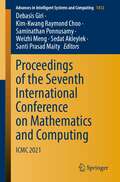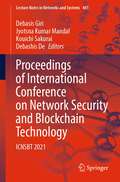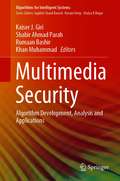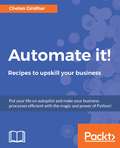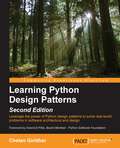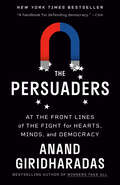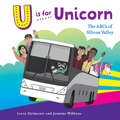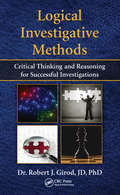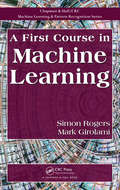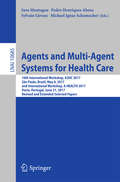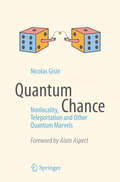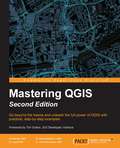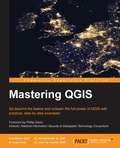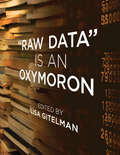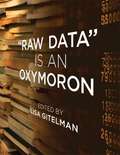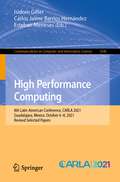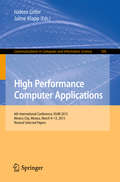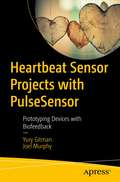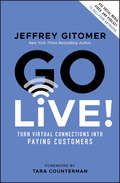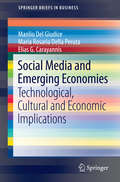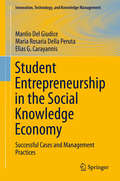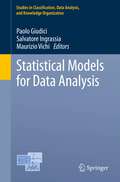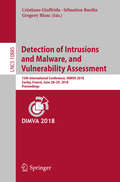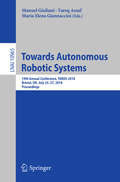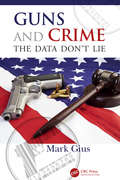- Table View
- List View
Proceedings of the Seventh International Conference on Mathematics and Computing: ICMC 2021 (Advances in Intelligent Systems and Computing #1412)
by Debasis Giri Kim-Kwang Raymond Choo Saminathan Ponnusamy Weizhi Meng Sedat Akleylek Santi Prasad MaityThis book features selected papers from the 7th International Conference on Mathematics and Computing (ICMC 2021), organized by Indian Institute of Engineering Science and Technology (IIEST), Shibpur, India, during March 2021. It covers recent advances in the field of mathematics, statistics, and scientific computing. The book presents innovative work by leading academics, researchers, and experts from industry.
Proceedings of International Conference on Network Security and Blockchain Technology: ICNSBT 2021 (Lecture Notes in Networks and Systems #481)
by Debasis Giri Jyotsna Kumar Mandal Kouichi Sakurai Debashis DeThe book is a collection of best selected research papers presented at International Conference on Network Security and Blockchain Technology (ICNSBT 2021), organized by Computer Society of India—Kolkata Chapter, India, during December 2–4, 2021. The book discusses recent developments and contemporary research in cryptography, network security, cyber security, and blockchain technology. Authors are eminent academicians, scientists, researchers, and scholars in their respective fields from across the world.
Multimedia Security: Algorithm Development, Analysis and Applications (Algorithms for Intelligent Systems)
by Kaiser J. Giri Shabir Ahmad Parah Rumaan Bashir Khan MuhammadThis book is a collection of outstanding content written by experts working in the field of multimedia security. It provides an insight about various techniques used in multimedia security and identifies its progress in both technological and algorithmic perspectives. In the contemporary world, digitization offers an effective mechanism to process, preserve and transfer all types of information. The incredible progresses in computing and communication technologies augmented by economic feasibility have revolutionized the world. The availability of efficient algorithms together with inexpensive digital recording and storage peripherals have created a multimedia era bringing conveniences to people in sharing the digital data that includes images, audio and video. The ever-increasing pace, at which the multimedia and communication technology is growing, has also made it possible to combine, replicate and distribute the content faster and easier, thereby empowering mankind by having a wealth of information at their disposal. However, security of multimedia is giving tough time to the research community around the globe, due to ever-increasing and efficient attacks carried out on multimedia data by intruders, eves-droppers and hackers. Further, duplication, unauthorized use and mal-distribution of digital content have become a serious challenge as it leads to copyright violation and is considered to be the principal reason that refrains the information providers in freely sharing their proprietary digital content. The book is useful for students, researchers and professionals to advance their study.
Automate it! - Recipes to upskill your business
by Chetan GiridharPut your life on autopilot and make your business processes efficient with the magic and power of Python! About This Book • Learn how to construct Python scripts to scrape data, manipulate files, and access websites' APIs • Get to know about the different types of bots, look at how to develop a simple chat bot and how bots can be used to automate business processes • This book is written in Python 3.5 syntax to future-proof your automation and you'll get an understanding of how to customize the scripts to meet your future automation needs Who This Book Is For Our audience is programmers who know Python but need not be experts. They will however know a lot of the basics of the syntax and some basic experience with the command line. Ultimately, they're people who see themselves as busy and want to find cool hacks to automate all the mundane and time-consuming tasks they find themselves doing on a daily basis. What You Will Learn • Implement file deduplication and how to parse HTML content in Python. • Study an example application that will enable you to work with spreadsheets • Get acquainted with the Python modules used to work with e-mails • Manipulate images using Pillow and schedule tasks with respect to time zones • Use XML or JSON as a message format across distributed systems • Develop a Python application with logging and see an example of debugging • Integrate Python with Mongo and Redis databases • Generate reports using Pandas In Detail This book gives you a great selection of recipes to automate your business processes with Python, and provides a platform for you to understand how Python is useful to make time consuming and repetitive business tasks more efficient. Python is a mature high level language, has object-oriented programming features, powers various apps, has a huge set of modules, and great community support. Python is extremely easy to use, can help you get complex tasks done efficiently and is an apt choice for our needs. With a classic problem-solution based approach and real-world examples, you will delve into things that automate your business processes. You will begin by learning about the Python modules to work with Web, Worksheets, Presentations and PDFs. You'll leverage Python recipes to automate processes in HR, Finance and making them efficient and reliable. For instance, company payroll — an integral process in HR will be automated with Python recipes. A few chapters of this book will also help you gain knowledge on working with bots and computer vision. You will learn how to build bots for automating business use cases by integrating artificial intelligence. You'll also understand how Python is helpful in face detection and building a scanner of your own. You will see how to effectively and easily use Python code to manage SMS and voice notifications, opening a world of possibilities using cloud telephony to solve your business needs. Moving forward, you will learn to work with APIs, Webhooks and Emails to automate Marketing and Customer Support processes. Finally, using the various Python libraries, this book will arm you with knowledge to customize data solutions and generate reports to meet your business needs. This book will help you up-skill and make your business processes efficient with the various Python recipes covered in this book. Style and approach Recipes to automate your life with Python will open your eyes to new ways to automate nearly anything you can achieve with a mouse and keyboard.In it, you'll learn how to construct Python scripts to scrape data, super-charge Excel, manipulate files, access websites APIs and much more. Our recipe-based approach will ensure that you know the purpose of a code block, and the steps you need to take to achieve that are presented in an easily digestible manner.
Learning Python Design Patterns - Second Edition
by Chetan GiridharLeverage the power of Python design patterns to solve real-world problems in software architecture and design About This Book * Understand the structural, creational, and behavioral Python design patterns * Get to know the context and application of design patterns to solve real-world problems in software architecture, design, and application development * Get practical exposure through sample implementations in Python v3.5 for the design patterns featured Who This Book Is For This book is for Software architects and Python application developers who are passionate about software design. It will be very useful to engineers with beginner level proficiency in Python and who love to work with Python 3.5 What You Will Learn * Enhance your skills to create better software architecture * Understand proven solutions to commonly occurring design issues * Explore the design principles that form the basis of software design, such as loose coupling, the Hollywood principle and the Open Close principle among others * Delve into the object-oriented programming concepts and find out how they are used in software applications * Develop an understanding of Creational Design Patterns and the different object creation methods that help you solve issues in software development * Use Structural Design Patterns and find out how objects and classes interact to build larger applications * Focus on the interaction between objects with the command and observer patterns * Improve the productivity and code base of your application using Python design patterns In Detail With the increasing focus on optimized software architecture and design it is important that software architects think about optimizations in object creation, code structure, and interaction between objects at the architecture or design level. This makes sure that the cost of software maintenance is low and code can be easily reused or is adaptable to change. The key to this is reusability and low maintenance in design patterns. Building on the success of the previous edition, Learning Python Design Patterns, Second Edition will help you implement real-world scenarios with Python's latest release, Python v3.5. We start by introducing design patterns from the Python perspective. As you progress through the book, you will learn about Singleton patterns, Factory patterns, and Facade patterns in detail. After this, we'll look at how to control object access with proxy patterns. It also covers observer patterns, command patterns, and compound patterns. By the end of the book, you will have enhanced your professional abilities in software architecture, design, and development. Style and approach This is an easy-to-follow guide to design patterns with hands-on examples of real-world scenarios and their implementation in Python v3.5. Each topic is explained and placed in context, and for the more inquisitive, there are more details on the concepts used.
The Persuaders: At the Front Lines of the Fight for Hearts, Minds, and Democracy
by Anand GiridharadasNEW YORK TIMES BESTSELLER • An insider account of activists, politicians, educators, and everyday citizens working to change minds, bridge divisions, and fight for democracy—from disinformation fighters to a leader of Black Lives Matter to Bernie Sanders and Alexandria Ocasio-Cortez and more—by the best-selling author of Winners Take All and award-winning former New York Times columnist&“Anand Giridharadas shows the way we get real progressive change in America—by refusing to write others off, building more welcoming movements, and rededicating ourselves to the work of changing minds.&” —Robert B. Reich, best-selling author of The SystemThe lifeblood of any free society is persuasion: changing other people&’s minds in order to change things. But America is suffering a crisis of faith in persuasion that is putting its democracy and the planet itself at risk. Americans increasingly write one another off instead of seeking to win one another over. Debates are framed in moralistic terms, with enemies battling the righteous. Movements for justice build barriers to entry, instead of on-ramps. Political parties focus on mobilizing the faithful rather than wooing the skeptical. And leaders who seek to forge coalitions are labeled sellouts.In The Persuaders, Anand Giridharadas takes us inside these movements and battles, seeking out the dissenters who continue to champion persuasion in an age of polarization. We meet a leader of Black Lives Matter; a trailblazer in the feminist resistance to Trumpism; white parents at a seminar on raising adopted children of color; Bernie Sanders and Alexandria Ocasio-Cortez; a team of door knockers with an uncanny formula for changing minds on immigration; an ex-cult member turned QAnon deprogrammer; and, hovering menacingly offstage, Russian operatives clandestinely stoking Americans&’ fatalism about one another.As the book&’s subjects grapple with how to call out threats and injustices while calling in those who don&’t agree with them but just might one day, they point a way to healing, and changing, a fracturing country.
U is for Unicorn: The ABCs of Silicon Valley
by Loren Girimonte Jasmine WibbensU is for Unicorn: The ABCs of Silicon Valley is a game-changing alphabet book about the lingo of the tech industry. From Angel Investor to Napping Pod to Zero-Emissions Vehicle, this witty book explores the world of the San Francisco Bay Area one letter at a time. Featuring buzzwords like Cryptocurrency, Hoodies, Rest and Vest, Moonshots, and more, these are the ABCs and ideas that innovators—from infants to Xennials—need to onboard now.• Pairs funny, knowing illustration with rhyming verse for each crucial concept• Follows a team of five talented employees (and one scrappy and resourceful raccoon)• Explores Silicon Valley culture letter-by-letterDisruptors of all ages can Pivot to next-gen success as they scale their learning and crush it to become the thought leaders of tomorrow. U is for Unicorn proves that Silicon Valley is rooted not just in a place, but in a state of mind anywhere Java (code and coffee) is flowing.
Logical Investigative Methods: Critical Thinking and Reasoning for Successful Investigations
by Robert J. GirodThis book describes how to use logic, reasoning, critical thinking, and the scientific method to conduct and improve criminal and civil investigations. The author discusses how investigators and attorneys can avoid assumptions and false premises and instead make valid deductions, inductions, and inferences. He explains how tools such as interview and interrogation can be used to detect deception and profile unknown individuals and suspects. The book is aimed at improving not only the conduct of investigations, but also the logical use of cognitive, analytical, documentation, and presentation tools to win cases.
A First Course in Machine Learning
by Mark GirolamiA First Course in Machine Learning covers the core mathematical and statistical techniques needed to understand some of the most popular machine learning algorithms. The algorithms presented span the main problem areas within machine learning: classification, clustering and projection. The text gives detailed descriptions and derivations for a smal
Agents and Multi-Agent Systems for Health Care: 10th International Workshop, A2HC 2017, São Paulo, Brazil, May 8, 2017, and International Workshop, A-HEALTH 2017, Porto, Portugal, June 21, 2017, Revised and Extended Selected Papers (Lecture Notes in Computer Science #10685)
by Sylvain Giroux Sara Montagna Pedro Henriques Abreu Michael Ignaz SchumacherThis book contains revised and extended selected papers from two workshops: the 10th International Workshop on Agents Applied in Health Care, A2HC 2017, held at the 16th International Conference on Autonomous Agents and Multiagent Systems, AAMAS 2017, held in S#65533;o Paulo, Brazil, in May 2017, and the International Workshop on Agents and Multi-Agent Systems for AAL and e-Health, A-HEALTH 2017, held at the 15th International Conference on Practical Applications of Agents and Multi-Agent Systems, PAAMS 2017, in Porto, Portugal, in June 2017. The 9 revised full papers were carefully reviewed and selected from 16 submissions. They feature current research topics such as personalised health systems for remote and autonomous tele-assistance, communication and co-operation between distributed intelligent agents to manage patient care, information agents that retrieve medical information from distributed repositories, intelligent and distributed data mining, and multi-agent systems that assist the doctors in the tasks of monitoring, decision support and diagnosis.
Quantum Chance: Nonlocality, Teleportation and Other Quantum Marvels
by Nicolas GisinQuantum physics, which offers an explanation of the world on the smallest scale, has fundamental implications that pose a serious challenge to ordinary logic. Particularly counterintuitive is the notion of entanglement, which has been explored for the past 30 years and posits an ubiquitous randomness capable of manifesting itself simultaneously in more than one place.This amazing 'non-locality' is more than just an abstract curiosity or paradox: it has entirely down-to-earth applications in cryptography, serving for example to protect financial information; it also has enabled the demonstration of 'quantum teleportation', whose infinite possibilities even science-fiction writers can scarcely imagine.This delightful and concise exposition does not avoid the deep logical difficulties of quantum physics, but gives the reader the insights needed to appreciate them. From 'Bell's Theorem' to experiments in quantum entanglement, the reader will gain a solid understanding of one of the most fascinating areas of contemporary physics.
Mastering QGIS - Second Edition
by Dr Richard Gisp Dr Luigi Pirelli Gisp Kurt Menke Dr John GispGo beyond the basics and unleash the full power of QGIS with practical, step-by-step examples About This Book * This book is your one-stop solution to all of your GIS needs using the open source QGIS * Master QGIS by learning about database integration, geoprocessing tools, Python scripts, advanced cartography, and custom plugins * This example-rich, practical guide will help you create sophisticated analyses and maps Who This Book Is For If you are a GIS professional, a consultant, a student, or perhaps a fast learner who wants to go beyond the basics of QGIS, then this book is for you. It will prepare you to realize the full potential of QGIS. What You Will Learn * Create and manage a spatial database * Get to know advanced techniques to style GIS data * Prepare both vector and raster data for processing * Add heat maps, live layer effects, and labels to your maps * Master LAStools and GRASS integration with the Processing Toolbox * Edit and repair topological data errors * Automate workflows with batch processing and the QGIS Graphical Modeler * Integrate Python scripting into your data processing workflows * Develop your own QGIS plugin In Detail QGIS is an open source solution to GIS. It is widely used by GIS professionals all over the world. It is the leading alternative to the proprietary GIS software. Although QGIS is described as intuitive, it is also by default complex. Knowing which tools to use and how to apply them is essential to producing valuable deliverables on time. Starting with a refresher on the QGIS basics, this book will take you all the way through to creating your first custom QGIS plugin. From the refresher, we will recap how to create, populate, and manage a spatial database. You'll also walk through styling GIS data, from creating custom symbols and color ramps to using blending modes. In the next section, you will discover how to prepare vector, heat maps, and create live layer effects, labeling, and raster data for processing. You'll also discover advanced data creation and editing techniques. The last third of the book covers the more technical aspects of QGIS such as using LAStools and GRASS GIS's integration with the Processing Toolbox, how to automate workflows with batch processing, and how to create graphical models. Finally, you will see how to create and run Python data processing scripts and write your own QGIS plugin with pyqgis. By the end of the book, you will understand how to work with all the aspects of QGIS, and will be ready to use it for any type of GIS work. Style and approach This step-by-step comprehensive guide will let you dig your teeth into working with spatial databases, creating your own QGIS plugins, and creating your own custom graphical models.
Mastering QGIS
by Kurt Menke Gisp Richard SmithIf you are a GIS professional, a consultant, a student, or perhaps a fast learner who wants to go beyond the basics of QGIS, then this book is for you. It will prepare you to realize the full potential of QGIS.
Raw Data Is an Oxymoron (Infrastructures)
by Lisa GitelmanEpisodes in the history of data, from early modern math problems to today's inescapable “dataveillance,” that demonstrate the dependence of data on culture. We live in the era of Big Data, with storage and transmission capacity measured not just in terabytes but in petabytes (where peta- denotes a quadrillion, or a thousand trillion). Data collection is constant and even insidious, with every click and every “like” stored somewhere for something. This book reminds us that data is anything but “raw,” that we shouldn't think of data as a natural resource but as a cultural one that needs to be generated, protected, and interpreted. The book's essays describe eight episodes in the history of data from the predigital to the digital. Together they address such issues as the ways that different kinds of data and different domains of inquiry are mutually defining; how data are variously “cooked” in the processes of their collection and use; and conflicts over what can—or can't—be “reduced” to data. Contributors discuss the intellectual history of data as a concept; describe early financial modeling and some unusual sources for astronomical data; discover the prehistory of the database in newspaper clippings and index cards; and consider contemporary “dataveillance” of our online habits as well as the complexity of scientific data curation. Essay Authors Geoffrey C. Bowker, Kevin R. Brine, Ellen Gruber Garvey, Lisa Gitelman, Steven J. Jackson, Virginia Jackson, Markus Krajewski, Mary Poovey, Rita Raley, David Ribes, Daniel Rosenberg, Matthew Stanley, Travis D. Williams
"Raw Data" Is an Oxymoron
by Lisa GitelmanWe live in the era of Big Data, with storage and transmission capacity measured not just in terabytes but in petabytes (where peta- denotes a quadrillion, or a thousand trillion). Data collection is constant and even insidious, with every click and every "like" stored somewhere for something. This book reminds us that data is anything but "raw," that we shouldn't think of data as a natural resource but as a cultural one that needs to be generated, protected, and interpreted. The book's essays describe eight episodes in the history of data from the predigital to the digital. Together they address such issues as the ways that different kinds of data and different domains of inquiry are mutually defining; how data are variously "cooked" in the processes of their collection and use; and conflicts over what can -- or can't -- be "reduced" to data. Contributors discuss the intellectual history of data as a concept; describe early financial modeling and some unusual sources for astronomical data; discover the prehistory of the database in newspaper clippings and index cards; and consider contemporary "dataveillance" of our online habits as well as the complexity of scientific data curation. Essay authors:Geoffrey C. Bowker, Kevin R. Brine, Ellen Gruber Garvey, Lisa Gitelman, Steven J. Jackson, Virginia Jackson, Markus Krajewski, Mary Poovey, Rita Raley, David Ribes, Daniel Rosenberg, Matthew Stanley, Travis D. Williams
High Performance Computing: 8th Latin American Conference, CARLA 2021, Guadalajara, Mexico, October 6–8, 2021, Revised Selected Papers (Communications in Computer and Information Science #1540)
by Isidoro Gitler Carlos Jaime Barrios Hernández Esteban MenesesThis book constitutes revised selected papers of the 8th Latin American High Performance Computing Conference, CARLA 2021, held in Guadalajara, Mexico, in October 2021. Due to the COVID-19 pandemic the conference was held in a virtual mode. The 16 revised full papers and 2 short papers presented were carefully reviewed and selected out of 45 submissions. The papers included in this book are organized according to the topics on high performance computing; high performance computing and artificial intelligence; high performance computing applications.
High Performance Computer Applications
by Isidoro Gitler Jaime KlappThis bookconstitutes the refereed proceedings of the 6th International Conference onSupercomputing, ISUM 2015, held in México, Mexico, in March 2015. The 38revised full papers presented were carefully reviewed and selected from 102submissions. The papers are organized in topical sections on perspectives insupercomputer infrastructure and applications; parallel algorithms andoptimization; HPC applications and simulations;
Heartbeat Sensor Projects with PulseSensor: Prototyping Devices with Biofeedback
by Yury Gitman Joel MurphyBring live heartbeats and heart rate data into your electronics projects as an impressive feature that builds user engagement. If you’re a Maker, developer, or artist, you’ve probably run into common, frustrating stumbling blocks for incorporating bio-sensors. Get the upper hand on smoothly integrating heartbeats into your projects on any platform with PulseSensor. First, you'll explore working with PulseSensor with a simple battery, LED, and speaker. Then deepen your knowledge by going through achievable projects using Arduino, nRF52, mico:bit, and other prototyping platforms. This book will guide you through hooking up the PulseSensor to circuits with motors, a GUI, and even the cloud. You’ll get practical tips and tricks that work in the lab, field, and even at public events, and look at the advantages of using PulseSensor on one electronics platform vs. another. You'll also look at the best ways to get a reliable heartbeat and BPM readings from different users in different applications. Finally, this book will show you the easiest path to put heartbeats into your prototypes, whether creating a new generation of hardware or making a memorable cosplay costume. What You'll LearnWork with PulseSensor directly on a breadboard with AA batteries and LEDs Get up and running with PulseSensor on Arduino, micro:bit, and nRF52 Anticipate and address common bio-sensing issues that slow down prototyping Explore future applications like BPM tracking on the Arduino IoT CloudWho This Book Is ForMakers from hobbyists to engineers to students who would like to incorporate cardiac biofeedback into their projects.
Go Live!: Turn Virtual Connections into Paying Customers
by Jeffrey GitomerLearn how to go online with a winning sales and marketing strategy in this insightful resource Go Live! Turn Virtual Connections into Paying Customers helps readers understand and take advantage of several online tools to boost their sales and increase their revenue. Accomplished salesperson, consultant, and online personality Jeffrey Gitomer describes how tools like Facebook Live and podcasting can drive sales and help you connect with your customers. You'll discover: How to use tools like YouTube, LinkedIn Live, podcasting, and Facebook Live to connect with and develop your leads How to properly utilize social media like Instagram and Twitter to spread your message and sell to clients How to promote and repurpose content to create as big an impact on your audience as possible Written specifically for a post-pandemic sales audience, Go Live! Turn Virtual Connections into Paying Customers delivers results for anyone expected to deliver sales results in a virtual environment. It also belongs on the bookshelves of those who hope to take their successful offline sales strategies to the online world.
Social Media and Emerging Economies
by Manlio Del Giudice Maria Rosaria Della Peruta Elias G. CarayannisHow have social media in emerging economies evolved differently from the rest of the world? According to studies and anecdotal evidence, innovations in the use of social media tools occur more frequently in emerging economies than they do in developed markets. The aim of this volume is to show that in emerging regions (such as China, India, and South America) where the participation of stakeholders in the circuit of social media is more active (i. e. , greater frequency of contacts and creativity in the elaboration of contents), organizations not only are involved in a set of exchange relations with other social actors but are also embedded in a network of dynamic relationships. The authors utilize social network analysis to determine how entrepreneurs in emerging economies identify their most beneficial social contacts and use those contacts to leverage the resources needed for their enterprises, revealing new insights on the process of business creation and economic development in the networked age.
Student Entrepreneurship in the Social Knowledge Economy
by Manlio Del Giudice Maria Rosaria Della Peruta Elias G. CarayannisTraditionally, the study of entrepreneurial behavior focuses on such factors as (i) the personality characteristics that distinguish the entrepreneur from non-entrepreneur and (ii) demographic characteristics such gender, age, familiar antecedents and education. With particular respect to investigating the development, acquisition, and dissemination of entrepreneurial skills and behaviors, the authors focus on the university environment, as a locus of research and innovation, where students are exposed to a wide variety of influences that are enhanced by a high degree of connectivity. The underlying theme of this volume is to develop our understanding of the sociology of student entrepreneurial behavior and in doing so attempt to synthesize literature investigating individual talent with the literature on concurrent knowledge sourcing in the pursuit of entrepreneurial activities. Specifically, the authors investigate the degree to which access to diverse knowledge (in addition to such psychological characteristics and tolerance of ambiguity and risk taking) influences the nature and probability of entrepreneurial success. Moreover, they explore the role of social media and social networking in facilitating access to distributed and disparate information and knowledge Their research addresses such timely questions as: Where do entrepreneurial opportunities come from? How can higher education best stimulate the creation of firms emanating from young and smart minds in colleges and universities? What is the value of MOOCs for frequent, early, and "thick" communication among the various specialties needed to accomplish entrepreneurial projects? How do we know whether social media affect students' responses to new knowledge and new ideas? To what extent do educational practices affect racial and ethnic differences in student entrepreneurship? What is the role of the indigenous minority student entrepreneur in establishing high-technology firms? The result is a multi-dimensional approach that sheds light on the dynamics of education, knowledge creation, social networking, innovation and new business development.
Statistical Models for Data Analysis
by Paolo Giudici Salvatore Ingrassia Maurizio VichiThe papers in this book cover issues related to the development of novel statistical models for the analysis of data. They offer solutions for relevant problems in statistical data analysis and contain the explicit derivation of the proposed models as well as their implementation. The book assembles the selected and refereed proceedings of the biannual conference of the Italian Classification and Data Analysis Group (CLADAG), a section of the Italian Statistical Society.
Detection of Intrusions and Malware, and Vulnerability Assessment: 15th International Conference, DIMVA 2018, Saclay, France, June 28–29, 2018, Proceedings (Lecture Notes in Computer Science #10885)
by Cristiano Giuffrida Sébastien Bardin Gregory BlancThis book constitutes the refereed proceedings of the 15th International Conference on Detection of Intrusions and Malware, and Vulnerability Assessment, DIMVA 2018, held in Saclay, France, in June 2018. The 17 revised full papers and 1 short paper included in this book were carefully reviewed and selected from 59 submissions. They present topics such as malware analysis; mobile and embedded security; attacks; detection and containment; web and browser security; and reverse engineering.
Towards Autonomous Robotic Systems: 19th Annual Conference, TAROS 2018, Bristol, UK July 25-27, 2018, Proceedings (Lecture Notes in Computer Science #10965)
by Manuel Giuliani Tareq Assaf Maria Elena GiannacciniThis book constitutes the refereed proceedings of the 19th Annual Conference on Towards Autonomous Robotics, TAROS 2018, held in Bristol, UK, in July 2018.The 38 full papers presented together with 14 short papers were carefully reviewed and selected from 68 submissions. The papers focus on presentation and discussion of the latest results and methods in autonomous robotics research and applications. The conference offers a friendly environment for robotics researchers and industry to take stock and plan future progress.
Guns and Crime: The Data Don't Lie
by Mark GiusGuns and Crime: The Data Don’t Lie investigates the ways in which the current data on guns and crime are inadequate and inaccurate. Although the majority of murders in the United States are committed with guns, research on gun ownership, the supply of guns, and the relationship between guns and crime is less thorough than studies done for many other aspects of public safety policy. This book explores the weaknesses in current findings, and extrapolates the implications of policymaking based on these faulty foundations. As the gun debate continues to rage in North America, this text offers a cautionary voice to the discourse—before practitioners and policy makers can create a solution to gun violence, they must first improve the quality of the facts they use to make their case. Intended for criminology, statistics, sociology, and economics students, Guns and Crime is also suitable for interested laypersons and practitioners hoping to better understand the mythos surrounding guns in America.
